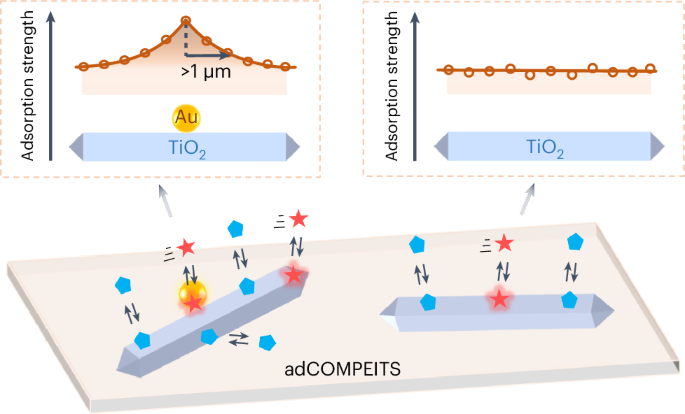金属促进的光催化剂对微污染物的长程吸附增强作用
IF 42.8
1区 化学
Q1 CHEMISTRY, PHYSICAL
引用次数: 0
摘要
光催化技术可有效降解废水中新出现的(微)污染物,实现先进的水处理目标,但太阳能转换效率低仍是一项挑战。一个关键的决定因素是对微污染物的有效吸附,这一点很难界定,特别是对于在不同长度尺度和(非)反应条件下具有表面异质性的光催化剂。在此,我们报告了一种可通用的成像技术 adCOMPEITS(基于吸附的竞争性超分辨率成像技术),并在非催化和光(电)催化条件下,以纳米分辨率量化了非荧光微污染物在异质结构金/二氧化钛光催化剂上的吸附行为。我们发现二氧化钛对微污染物的长程吸附增强达到了微米级,这源于二氧化钛在接触金属助催化剂时的长程表面带弯曲。我们进一步设计了带弯曲,以有效调节分子吸附的长程效应。这项成像技术和科学发现将为了解和设计金属促进的光催化剂的多种应用开辟道路。本文章由计算机程序翻译,如有差异,请以英文原文为准。


Long-range enhancements of micropollutant adsorption on metal-promoted photocatalysts
Photocatalysis can effectively degrade emerging (micro)pollutants in wastewater and achieve advanced water treatment objectives, wherein the low solar energy conversion efficiency remains a challenge. One key determinant is the effective adsorption of micropollutants, which is challenging to define, especially for photocatalysts with surface heterogeneity over different length scales and under (non-)reactive conditions. Here we report a generalizable imaging technique adCOMPEITS (adsorption-based competition-enabled imaging technique with super-resolution) and quantify the adsorption behaviours of non-fluorescent micropollutants on heterostructured Au/TiO2 photocatalysts at nanometre resolution under both non-catalytic and photo(electro)catalytic conditions. We discover a long-range enhancement of micropollutant adsorption on TiO2, which reaches micrometre-length scale and stems from the long-range surface band bending of TiO2 upon contacting metal co-catalyst. We further engineer the band bending to effectively modulate the long-range effects on molecular adsorption. The imaging technique and the scientific discoveries here should open avenues towards understanding and engineering metal-promoted photocatalysts for many applications. Methods for studying the adsorption behaviour of molecules onto surfaces under reactive and non-reactive conditions are needed to improve photocatalysts for water treatment. Here the authors develop an imaging technique, adCOMPEITS, to quantify the adsorption of micropollutants on Au/TiO2 and identify a long-range enhancement effect.
求助全文
通过发布文献求助,成功后即可免费获取论文全文。
去求助
来源期刊

Nature Catalysis
Chemical Engineering-Bioengineering
CiteScore
52.10
自引率
1.10%
发文量
140
期刊介绍:
Nature Catalysis serves as a platform for researchers across chemistry and related fields, focusing on homogeneous catalysis, heterogeneous catalysis, and biocatalysts, encompassing both fundamental and applied studies. With a particular emphasis on advancing sustainable industries and processes, the journal provides comprehensive coverage of catalysis research, appealing to scientists, engineers, and researchers in academia and industry.
Maintaining the high standards of the Nature brand, Nature Catalysis boasts a dedicated team of professional editors, rigorous peer-review processes, and swift publication times, ensuring editorial independence and quality. The journal publishes work spanning heterogeneous catalysis, homogeneous catalysis, and biocatalysis, covering areas such as catalytic synthesis, mechanisms, characterization, computational studies, nanoparticle catalysis, electrocatalysis, photocatalysis, environmental catalysis, asymmetric catalysis, and various forms of organocatalysis.
 求助内容:
求助内容: 应助结果提醒方式:
应助结果提醒方式:


